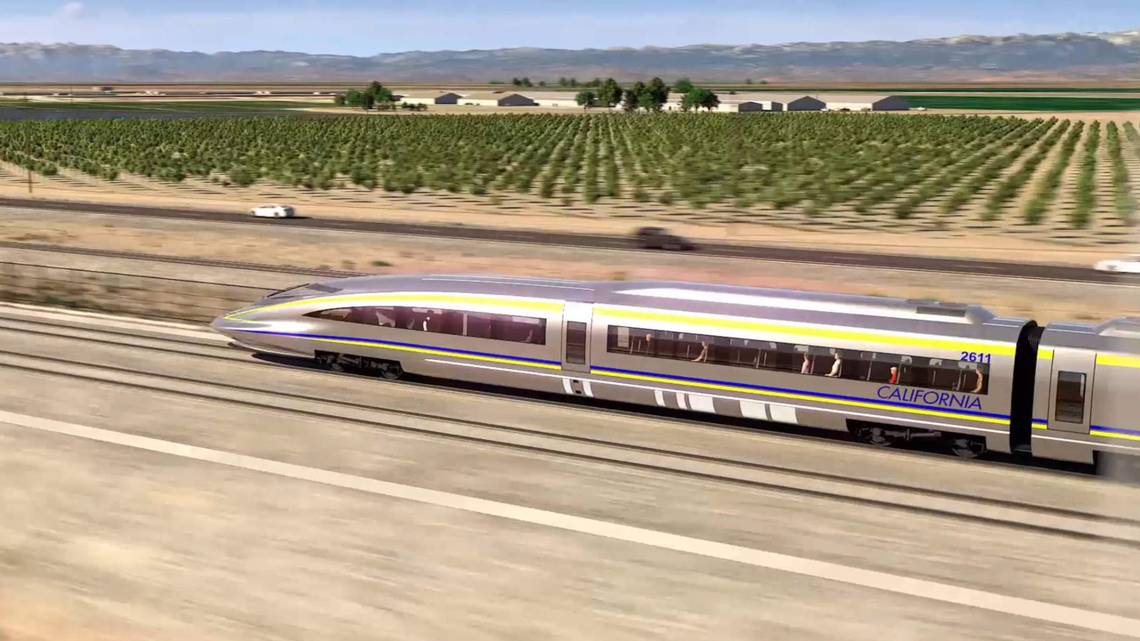An artist’s drawing depicts a high-speed rail line running through the southern San Joaquin Valley.
California High Speed Rail Authority
The real high speed train from Spain’s Madrid to Barcelona is about the same length as the yet-mythical ride in California from San Jose to Los Angeles. Boarding in Madrid just after Thanksgiving, my train took two hours and 45 minutes at a one-way price as low as about $40. Leaving slowly from Madrid’s Atocha station, the gleaming red train known as Iryo quickly launched us at speeds approaching 180 miles per hour to an on-time arrival.
[–>[–>
The high speed rail that transformed Spain and much of Europe has remained elusive here in California. For years, the maiden north-south effort has sputtered and faltered. Heading into this year, the last time the federal government gave it some big help was when Joe Biden was vice president.
[–>
President Biden changed that earlier this month. Dipping into funds from his 2021 Bipartisan Infrastructure Deal, he gave the California High-Speed Rail Authority a much-needed infusion of $3.1 billion.
[–>
If history is any indication, the nation’s first high-speed rail project faces two potentially formidable adversaries. First, the CHSRA is banking on another $4.9 billion help from Washington, and that can only happen if the next president is supportive of the project. Second, the project cannot afford another round of cost increases that would trigger more delays, overruns and skepticism.
[–>
“The United States … is building the most expensive high speed rail projects in the world,” New York University Professor Eric Goldwyn said at a May conference of the world’s high rail executives in Washington, D.C.
[–>
Based on NYU’s global research, that 386-mile line from Madrid to Barcelona cost approximately $25 million a mile, adjusted to today’s dollars, when it was completed in 2008. Meanwhile, in California, the goal is to stick to a budget — and receive that final bucket of federal support — to keep costs for the initial 172-leg at $33 billion. That’s more than $192 million a mile. The difference is breathtaking.
[–>
Why?
[–>
“Infrastructure is expensive, whether it is highways or airports,” said Brian Annis, the chief financial officer for CHSRA. Any other new California transportation project by road or plane to move as many people as envisioned by this project would be “more expensive.”
[–>
Spain, with a combination of fortune and savvy, has become high speed rail’s equivalent of The Little Engine that Could.
[–>
Mercedes Sierra, chief executive of a Spanish engineering firm that helped build the 2,500-mile system (second in miles only to China), attributes the country’s success to three ingredients: steady funding, an early success and some risk taking.
[–>
Unlike the federal government, the European Union “helped us catch up with the other European countries,” said Mercedes, who leads Sener Engineering and Systems. “It is very difficult to build this mega-project based on a stop and go system.”
[–>
The first high speed line from Madrid to Seville, constructed in 1992 in just four years, gave the country an early taste of what was coming.
[–>
“If you are mired in delays and overruns, it has to be demoralizing,” she said. And when Spain made the bold decision to open the tracks to operators, ticket costs on the routes dropped by 50%.
[–>
Here in California, it’s been 15 years since California voters narrowly agreed to borrow nearly $10 billion to begin building a high-speed rail system in the state. The project has neither experienced steady funding since then or an early success. And Gov. Gavin Newsom fundamentally altered the strategy in his first year, abandoning attempts to build a line connecting Northern and Southern California and focusing on this 171-mile stretch within the Central Valley instead.
[–>
At the May high speed rail conference, Goldwyn of NYU said his research suggests that the country simply has more regulations, inter-government problems and higher labor costs. As one example, it took three years for workers in New York to build a shaft to launch a machine to dig a new subway tunnel.
[–>
“When they do it in any other part of the world that does it cheaply, it takes six months,” he said.
[–>
Brian Kelly, CEO of the CHSRA, told the conference that in California, “we’re going to spend $1.3 billion on the environmental (permitting). That is a staggering figure.”
[–>
In May, Kelly did not know whether the Biden administration would contribute the $8 billion that is needed to help complete the Merced-Bakersfield portion of the project, extending the 119 middle miles largely constructed to the 171-mile system. Without the funding, “I am building a 119-mile test track and waiting,” he said. With the money, “I am building an operational segment.”
[–>
That appears in reach depending on who is in the White House come 2025.
[–>
The $3.1 billion announced by the administration earlier this month represents largely what the CHSRA requested. It should finish all design and build the line from the Meadows Field Airport in Bakersfield north towards Wasco. There are ongoing grant application cycles in the immediate years ahead, Annis said.
[–>
But this process is expected to take about three more years — meaning unprecedented support from consecutive presidents.
[–>
We aren’t Spain. That is true in patterns of growth, governance and most definitely how we build rail. But California is now more than $30 billion into this grand experiment. Abandoning the Bakersfield-Merced first phase, when service could begin as early as 2030, would be utter folly.
[–>
Driving down future costs is the only realistic way to build a north-south system. A Democrat in leadership needs the bravery to champion the lowering of rail’s cost in Sacramento. The labor, environmental and government lobbies will hate it.
[–>
When it comes to taking the tough steps to learn from the rest of the world and save ourselves from the automobile, California is in the proverbial caboose.

